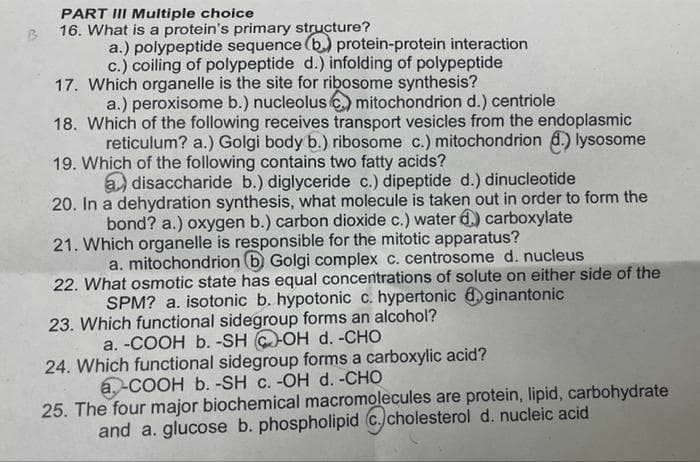B PART III Multiple choice 16. What is a protein's primary structure? a.) polypeptide sequence (b) protein-protein interaction c.) coiling of polypeptide d.) infolding of polypeptide 17. Which organelle is the site for ribosome synthesis? a.) peroxisome b.) nucleolus mitochondrion d.) centriole 18. Which of the following receives transport vesicles from the endoplasmic reticulum? a.) Golgi body b.) ribosome c.) mitochondrion d.) lysosome 19. Which of the following contains two fatty acids? a disaccharide b.) diglyceride c.) dipeptide d.) dinucleotide 20. In a dehydration synthesis, what molecule is taken out in order to form the bond? a.) oxygen b.) carbon dioxide c.) water ) carboxylate 21. Which organelle is responsible for the mitotic apparatus? a. mitochondrion b Golgi complex c. centrosome d. nucleus 22. What osmotic state has equal concentrations of solute on either side of the SPM? a. isotonic b. hypotonic c. hypertonic @ginantonic 23. Which functional sidegroup forms an alcohol? a. -COOH b. -SHOH d. -CHO 24. Which functional sidegroup forms a carboxylic acid? a-COOH b. -SH c. -OH d. -CHO 25. The four major biochemical macromolecules are protein, lipid, carbohydrate and a. glucose b. phospholipid cholesterol d. nucleic acid
B PART III Multiple choice 16. What is a protein's primary structure? a.) polypeptide sequence (b) protein-protein interaction c.) coiling of polypeptide d.) infolding of polypeptide 17. Which organelle is the site for ribosome synthesis? a.) peroxisome b.) nucleolus mitochondrion d.) centriole 18. Which of the following receives transport vesicles from the endoplasmic reticulum? a.) Golgi body b.) ribosome c.) mitochondrion d.) lysosome 19. Which of the following contains two fatty acids? a disaccharide b.) diglyceride c.) dipeptide d.) dinucleotide 20. In a dehydration synthesis, what molecule is taken out in order to form the bond? a.) oxygen b.) carbon dioxide c.) water ) carboxylate 21. Which organelle is responsible for the mitotic apparatus? a. mitochondrion b Golgi complex c. centrosome d. nucleus 22. What osmotic state has equal concentrations of solute on either side of the SPM? a. isotonic b. hypotonic c. hypertonic @ginantonic 23. Which functional sidegroup forms an alcohol? a. -COOH b. -SHOH d. -CHO 24. Which functional sidegroup forms a carboxylic acid? a-COOH b. -SH c. -OH d. -CHO 25. The four major biochemical macromolecules are protein, lipid, carbohydrate and a. glucose b. phospholipid cholesterol d. nucleic acid
Biology: The Dynamic Science (MindTap Course List)
4th Edition
ISBN:9781305389892
Author:Peter J. Russell, Paul E. Hertz, Beverly McMillan
Publisher:Peter J. Russell, Paul E. Hertz, Beverly McMillan
Chapter26: Prokaryotes: Bacteria And Archaea
Section: Chapter Questions
Problem 11TYK
Related questions
Question
Write type answer

Transcribed Image Text:PART III Multiple choice
B 16. What is a protein's primary structure?
17.
a.) polypeptide sequence (b) protein-protein interaction
c.) coiling of polypeptide d.) infolding of polypeptide
Which organelle is the site for ribosome synthesis?
a.) peroxisome b.) nucleolus mitochondrion d.) centriole
18. Which of the following receives transport vesicles from the endoplasmic
reticulum? a.) Golgi body b.) ribosome c.) mitochondrion d.) lysosome
19. Which of the following contains two fatty acids?
a disaccharide b.) diglyceride c.) dipeptide d.) dinucleotide
20. In a dehydration synthesis, what molecule is taken out in order to form the
bond? a.) oxygen b.) carbon dioxide c.) water d) carboxylate
21. Which organelle is responsible for the mitotic apparatus?
a. mitochondrion b Golgi complex c. centrosome d. nucleus
22. What osmotic state has equal concentrations of solute on either side of the
SPM? a. isotonic b. hypotonic c. hypertonic @ginantonic
23. Which functional sidegroup forms an alcohol?
a. -COOH b. -SHOH d. -CHO
24. Which functional sidegroup forms a carboxylic acid?
a-COOH b. -SH c. -OH d. -CHO
25. The four major biochemical macromolecules are protein, lipid, carbohydrate
and a. glucose b. phospholipid (c. cholesterol d. nucleic acid
Expert Solution
This question has been solved!
Explore an expertly crafted, step-by-step solution for a thorough understanding of key concepts.
Introduction
VIEW16. What is a protein's primary structure?
VIEW17. Which organelle is the site for ribosome synthesis?
VIEW18. Which of the following receives transport vesicles from the endoplasmic reticulum?
VIEW19. Which of the following contains two fatty acids?
VIEW20. In a dehydration synthesis, what molecule is taken out in order to form the bond?
VIEW21. Which organelle is responsible for the mitotic apparatus?
VIEW22. What osmotic state has equal concentrations of solute on either side of the SPM?
VIEWFunctional groups
VIEW25. The four major biochemical macromolecules are protein, lipid, carbohydrate and
VIEWStep by step
Solved in 10 steps

Recommended textbooks for you

Biology: The Dynamic Science (MindTap Course List)
Biology
ISBN:
9781305389892
Author:
Peter J. Russell, Paul E. Hertz, Beverly McMillan
Publisher:
Cengage Learning

Anatomy & Physiology
Biology
ISBN:
9781938168130
Author:
Kelly A. Young, James A. Wise, Peter DeSaix, Dean H. Kruse, Brandon Poe, Eddie Johnson, Jody E. Johnson, Oksana Korol, J. Gordon Betts, Mark Womble
Publisher:
OpenStax College

Concepts of Biology
Biology
ISBN:
9781938168116
Author:
Samantha Fowler, Rebecca Roush, James Wise
Publisher:
OpenStax College

Biology: The Dynamic Science (MindTap Course List)
Biology
ISBN:
9781305389892
Author:
Peter J. Russell, Paul E. Hertz, Beverly McMillan
Publisher:
Cengage Learning

Anatomy & Physiology
Biology
ISBN:
9781938168130
Author:
Kelly A. Young, James A. Wise, Peter DeSaix, Dean H. Kruse, Brandon Poe, Eddie Johnson, Jody E. Johnson, Oksana Korol, J. Gordon Betts, Mark Womble
Publisher:
OpenStax College

Concepts of Biology
Biology
ISBN:
9781938168116
Author:
Samantha Fowler, Rebecca Roush, James Wise
Publisher:
OpenStax College

Biology 2e
Biology
ISBN:
9781947172517
Author:
Matthew Douglas, Jung Choi, Mary Ann Clark
Publisher:
OpenStax

Biology (MindTap Course List)
Biology
ISBN:
9781337392938
Author:
Eldra Solomon, Charles Martin, Diana W. Martin, Linda R. Berg
Publisher:
Cengage Learning